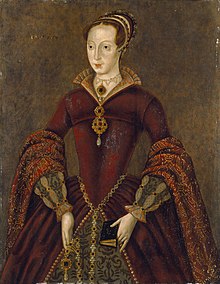
Back Lady Jane Grey Afrikaans Iane Grǣġ Hlǣfdīġe ANG ليدي جين غراي Arabic ليدى جين جراى ARZ Xuana Grey AST Ceyn Qrey Azerbaijani جین قری AZB Джэйн Грэй Byelorussian Джейн Грей Bulgarian Jane Grey Breton
| Lady Jane Grey | |
|---|---|
 The Streatham portrait, discovered at the beginning of the 21st century, is believed to be based on a contemporary woodcut. | |
| Queen of England and Ireland | |
| Reign | 10 July 1553 – 19 July 1553[1] |
| Predecessor | Edward VI |
| Successor | Mary I |
| Born | 1536 or 1537 Possibly London or Bradgate Park, Leicestershire, England |
| Died | 12 February 1554 (aged 16 or 17)[2][3][4][5] Tower of London, London, England |
| Burial | Church of St Peter ad Vincula, Tower of London |
| Spouse | |
| House | Grey |
| Father | Henry Grey, 1st Duke of Suffolk |
| Mother | Lady Frances Brandon |
| Religion | Protestantism |
| Signature | |
Lady Jane Grey (c. 1537 – 12 February 1554), also known as Lady Jane Dudley after her marriage[3] and as the "Nine Days' Queen",[6] was an English noblewoman who claimed the throne of England and Ireland from 10 to 19 July 1553.
Jane was the great-granddaughter of King Henry VII through his daughter, Mary Tudor, and was therefore a great-niece of King Henry VIII, and a cousin to Edward VI, Mary I and Elizabeth I. Under the will of Henry VIII, Jane was in line to the throne after her cousins. She had a humanist education; and a reputation as one of the most learned young women of her day.[7] In May 1553, she was married to Lord Guildford Dudley, a younger son of Edward VI's chief minister John Dudley, Duke of Northumberland. In June 1553, the dying Edward VI wrote his will, nominating Jane and her male heirs as successors to the Crown, in part because his half-sister Mary was Catholic, while Jane was a committed Protestant and would support the reformed Church of England, whose foundation Edward laid. The will removed his half-sisters, Mary and Elizabeth, from the line of succession on account of their illegitimacy, subverting their lawful claims under the Third Succession Act. Through Northumberland, Edward's letters patent in favour of Jane was signed by the entire privy council, bishops, and other notables.
After Edward's death, Jane was proclaimed queen on 10 July 1553, and awaited coronation in the Tower of London. Support for Mary grew rapidly and most of Jane's supporters abandoned her. The Privy Council of England suddenly changed sides, and proclaimed Mary as queen on 19 July 1553, deposing Jane. Her primary supporter, her father-in-law, the Duke of Northumberland, was accused of treason, and executed less than a month later. Jane was held prisoner in the Tower, and in November 1553 was also convicted of treason, which carried a sentence of death.
Mary initially spared her life, but Jane soon became viewed as a threat to the Crown when her father, Henry Grey, 1st Duke of Suffolk, became involved with Wyatt's rebellion against Queen Mary's intention to marry Philip of Spain. Jane and her husband were executed on 12 February 1554. At the time of her execution, Jane was either 16 or 17 years old.
- ^ Williamson, David (2010). Kings & Queens. National Portrait Gallery Publications. p. 95. ISBN 978-1-85514-432-3
- ^ Ives 2009, p. 36; Florio 1607, p. 68
- ^ a b Cite error: The named reference
ODNBwas invoked but never defined (see the help page). - ^ "Lady Jane Grey | Biography, Facts, & Execution". Encyclopedia Britannica. Retrieved 10 July 2021.
- ^ Cite error: The named reference
potterwas invoked but never defined (see the help page). - ^ Ives 2009, p. 2
- ^ Ascham 1863, p. 213
© MMXXIII Rich X Search. We shall prevail. All rights reserved. Rich X Search